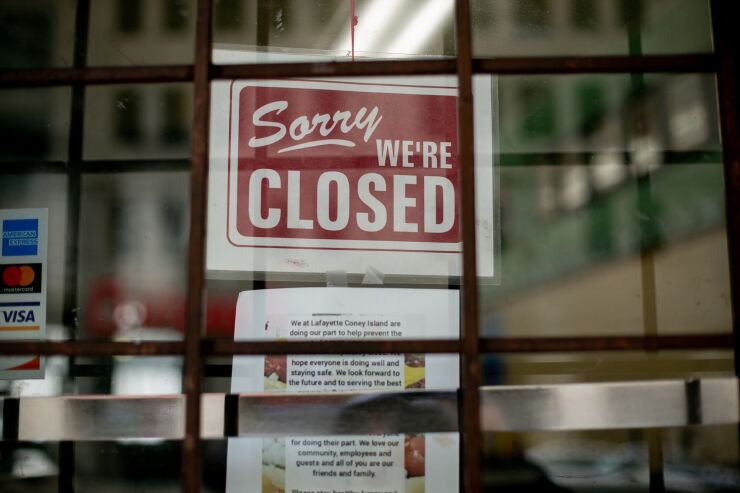Small businesses that struggled to get loans from a government pandemic relief program still don’t know how much they may have to repay after the government missed a deadline to give specific guidance.
The U.S. Small Business Administration was supposed to clarify by April 26 how loans it approved as part of the Trump administration’s multitrillion-dollar coronavirus stimulus package can be spent and still qualify to become grants.
Companies and lenders say they need more guidance on how to calculate the amount that’s eligible for forgiveness and what documentation is required to support the claims. That could leave small firms on the hook to repay loan proceeds they thought would be a grant. As a result, some business owners are holding onto the loans and may even return them, according to interviews with small business groups, lenders and borrowers.

The
“As soon as they got the money, they’re calling and saying, ‘OK, how do I spend this to make sure I get this forgiven, because I don’t want to mess this up,’” said
The uncertainty about how loans will be forgiven is just the latest stumbling block in the SBA’s chaotic effort to funnel about $670 billion to small firms across the country to counter the devastating effects of Covid-19 on their operations. The initiative was intended to keep them afloat and keep employees on payrolls to be ready to reopen.
The initial round of $349 billion in funding
The program provides loans of as much as $10 million to small businesses affected by the outbreak. The law says borrowers don’t have to repay the loans if the money is spent on payroll plus mortgage interest, rent and utilities. An initial
Business owners don’t have enough guidance about how they’re spending the money to ensure they’ll avoid having to repay it, said Holly Wade, director of research and policy analysis for the National Federation of Independent Business. Questions include whether expenses incurred during the eight weeks but paid later would qualify. They’d also like more flexibility about how the proceeds can be used and still qualify for forgiveness. Small business and industry groups are lobbying Congress and the Trump administration for changes.
“There’s just many questions where we don’t have an answer, and small business owners are concerned,” Wade said.
Congress said in the legislation creating the program that the SBA was to issue guidance and regulations for loan forgiveness “not later than 30 days after the date of enactment of this act,” which would have been April 26. Almost a week on, the agency hasn’t said when it will issue the guidance and didn’t comment for this report.
The program was designed to have banks disburse loans to small businesses that SBA would guarantee, to get money into the hands of those in need as quickly as possible. Lenders can apply to have the agency reimburse them for the portions of loans that are forgiven, starting seven weeks after money is disbursed.
Lenders also want more guidance because they make the initial assessment about loan forgiveness, said Paul Merski of the Independent Community Bankers of America. The SBA and Treasury should produce a calculator to help lenders and borrowers determine loan forgiveness and simplify the process, he said.
The rollout of the small business relief program last month had numerous problems. SBA’s lending platform was quickly overwhelmed, and guidance to borrowers and banks, which has changed dozens of times since it launched April 3, sowed confusion and caused banks to hold back on processing applications initially.
Large firms and national chains
After the Trump administration
Texas hotelier Monty Bennett, a major donor to President Donald Trump whose companies are among the biggest known recipients of loans that total about $70 billion, according to regulatory filings,
James Cummings, who runs 22 Great Clips franchises across North Carolina, said he received a loan for his hair salons toward the end of April, but is holding on to it until he gets more details on how the forgiveness will work. He’s hoping that the government will allow more flexibility in how he spends it.
Cummings said he needs to “be able to use this money when we reopen, or we’re literally going to have to pay it all back, every dime.”
The salon operator is among small business owners that are finding themselves caught in an additional bind: even with a loan, they can’t pay their employees as much as the workers could get from unemployment benefits, but they can’t use more of the money to cover other expenses while waiting to reopen.
Many restaurants and other small business owners also
Advocates also want more flexibility to the rule on how the proceeds can be spent, but Mnuchin has defended the terms because the intent of the law was to keep workers employed.
Clara Osterhage, who owns hair salons in Ohio and other states, got her loan funds on April 26, but doesn’t know when she’ll be able to reopen and whether she can rehire workers. She said she needs more clarity about the rules and may end up having to return the money rather than having to repay with interest a two-year loan she can’t afford.
“It’s incredibly concerning,” Osterhage said. “I don’t know the rules of the game, and I have no control.”





